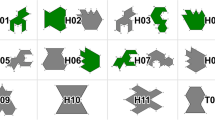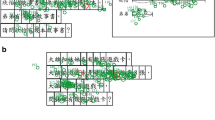Abstract
This study concerns the cognitive process of mathematical problem posing, conceptualized in three stages: understanding the task, constructing the problem, and expressing the problem. We used the eye tracker and think-aloud methods to deeply explore students’ behavior in these three stages of problem posing, especially focusing on investigating the influence of task situation format and mathematical maturity on students’ thinking. The study was conducted using a 2 × 2 mixed design: task situation format (with or without specific numerical information) × subject category (master’s students or sixth graders). Regarding the task situation format, students’ performance on tasks with numbers was found to be significantly better than that on tasks without numbers, which was reflected in the metrics of how well they understood the task and the complexity and clarity of the posed problems. In particular, students spent more fixation duration on understanding and processing the information in tasks without numbers; they had a longer fixation duration on parts involving presenting uncertain numerical information; in addition, the task situation format with or without numbers had an effect on students’ selection and processing of information related to the numbers, elements, and relationships rather than information regarding the context presented in the task. Regarding the subject category, we found that mathematical maturity did not predict the quantity of problems posed on either type of task. There was no significant main group difference found in the eye-movement metrics.







Similar content being viewed by others
Data availability
The dataset generated during the current study is not publicly available as it contains private information of participants that the authors acquired through video recording. Information on how to obtain it and reproduce the analysis is available from the corresponding author on request.
Notes
An example of the problems posed by a sixth grader and a master’s student on the House Purchase Task is shown in Appendix 3.
References
Bai, X., Li, X., & Yan, G. (2015). Eye movement control in Chinese reading: A summary over the past 20 years of research. Psychological Development and Education, 32(1), 85–91. in Chinese.
Barmby, P., Andra, C., Gomez, D., Obersteiner, A., & Shvarts, A. (2014). The use of eye-tracking technology in mathematics education research. Proceedings of the Joint Meeting of PME, 38, 253.
Baumanns, L., & Rott, B. (2022). The process of problem posing: Development of a descriptive phase model of problem posing. Educational Studies in Mathematics, 110(2), 251–269.
Bicer, A., Lee, Y., Perihan, C., Capraro, M. M., & Capraro, R. M. (2020). Considering mathematical creative self-efficacy with problem posing as a measure of mathematical creativity. Educational Studies in Mathematics, 105(3), 457–485.
Bonotto, C., & Santo, L. D. (2015). On the relationship between problem posing, problem solving, and creativity in primary school. In F. M. Singer, N. Ellerton, & J. Cai (Eds.), Mathematical problem posing: From research to effective practice (pp. 103–124). Springer.
Brown, S. I., & Walter, M. I. (1993). In the classroom: Student as author and critic. In S. I. Brown & M. I. Walter (Eds.), Problem posing: Reflections and applications (pp. 7–16). Psychology Press.
Cai, J. (2022). What research says about teaching mathematics through problem posing. Éducationet Didactique, 16(3), 31–50.
Cai, J., & Cifarelli, V. (2005). Exploring mathematical exploration: How two college students formulated and solved their own mathematical problems. Focus on Learning Problems in Mathematics, 27(3), 43–72.
Cai, J., & Hwang, S. (2002). Generalized and generative thinking in U.S. and Chinese students’ mathematical problem solving and problem posing. The Journal of Mathematical Behavior, 21, 401–421.
Cai, J., & Jiang, C. (2017). An analysis of problem-posing tasks in Chinese and US elementary mathematics textbooks. International Journal of Science and Mathematics Education, 15(8), 1521–1540.
Cai, J., & Leikin, R. (2020). Affect in mathematical problem posing: Conceptualization, advances, and future directions for research. Educational Studies in Mathematics, 105, 287–301.
Cai, J., Hwang, S., Jiang, C., & Silber, S. (2015). Problem posing research in mathematics education: Some answered and unanswered questions. In F. Singer, N. Ellerton, & J. Cai (Eds.), Mathematical problem posing: From research to effective practice (pp. 3–34). Springer.
Cai, J., & Hwang, S. (2023). Making mathematics challenging through problem posing in the classroom. In Leikin, R. (eds). Mathematical challenges for all. Research in Mathematics Education (pp.115–145). Springer, Cham.
Cai, J., & Rott, B. (2023). On understanding mathematical problem-posing processes. ZDM - Mathematics Education. Online First. https://doi.org/10.1007/s11858-023-01536-w.
Cai, J., Koichu, B., Rott, B., Zazkis, R., & Jiang, C. (2022). Mathematical problem posing: Task variables, processes, and products. Proceeding of the 45th Conference of the International Group for the Psychology of Mathematics Education (Vol. 1, pp. 119–145). Spain, Alicante.
Caldara, R., & Miellet, S. (2011). iMap: A novel method for statistical fixation mapping of eye movement data. Behavior Research Methods, 43, 864–878.
Carroll, D. W. (1986). Psychology of language. Thomson Brooks/Cole.
Chen, L., & Zheng, X. (2014). An eye-movement study on problem finding process of undergraduates. Acta Psychologica Sinica., 46(3), 367–384. in Chinese.
Chou, P., & Zhou, A. (2011). Influencing factors for the THOG problem: An eye-movement study. Journal of Southwest University (natural Science Edition), 33(2), 167–172. in Chinese.
Christou, C., Mousoulides, N., Pittalis, M., Pitta-Pantazi, D., & Sriraman, B. (2005). An empirical taxonomy of problem posing processes. ZDM-Mathematics Education, 37(3), 149–158.
Cifarelli, V. V., & Cai, J. (2005). The evolution of mathematical explorations in open-ended problem-solving situations. The Journal of Mathematical Behavior, 24(3–4), 302–324.
Cohen, J. (1988). Statistical power analysis for the behavioral sciences (2nd ed.). Lawrence Erlbaum Associates.
Crespo, S., & Sinclair, N. (2008). What makes a problem mathematically interesting? Inviting prospective teachers to pose better problems. Journal of Mathematics Teacher Education, 11(5), 395–415.
Cummins, D. D., Kintsch, W., Reusser, K., & Weimer, R. (1988). The role of understanding in solving word problems. Cognitive Psychology, 20(4), 405–438.
Daroczy, G., Wolska, M., Meurers, W. D., & Nuerk, H. C. (2015). Word problems: A review of linguistic and numerical factors contributing to their difficulty. Frontiers in Psychology, 6, 348.
Dogusoy-Taylan, B., & Cagiltaly, K. (2014). Cognitive analysis of experts’ and novices’ concept mapping processes: An eye tracking study. Computers in Human Behavior, 36, 82–93.
Einstein, A., & Infeld, L. (1938). The evolution of physics: The growth of ideas from early concepts to relativity and quanta. Cambridge University Press.
Ellerton, N. F. (1986). Children’s made-up mathematics problems—A new perspective on talented mathematicians. Educational Studies in Mathematics, 17, 261–271.
English, L. D. (1998). Children’s problem posing within formal and informal contexts. Journal for Research in Mathematics Education, 29(1), 83–106.
Gegenfurtner, A., Lehtinen, E., & Saljo, R. (2011). Expertise differences in the comprehension of visualizations: A meta-analysis of eye-tracking research in professional domains. Educational Psychology Review, 23(4), 523–552.
Goldin, G. A., & McClintock, C. E. (1984). Task variables in mathematical problem solving. Franklin Institute Press.
Hartmann, M. (2015). Numbers in the eye of the beholder: What do eye movements reveal about numerical cognition? Cognitive Processing, 16, S245–S248.
Hegarty, M., Mayer, R. E., & Green, C. E. (1992). Comprehension of arithmetic word problems: Evidence from students’ eye fixations. Journal of Educational PsychOlogy, 84(1), 76–84.
Hegarty, M., Mayer, R. E., & Monk, C. A. (1995). Comprehension of arithmetic word problems: A comparison of successful and unsuccessful problem solvers. Journal of Educational Psychology, 87(1), 18–32.
Holmqvist, K., Nyström, M., Andersson, R., Dewhurst, R., Jarodzka, H., & Van de Weijer, J. (2011). Eye tracking: A comprehensive guide to methods and measures. OUP Oxford.
Junior, L. R. S., Cesar, F. H. G., Rocha, F. T., & Thomaz, C. E. (2017). EEG and eye movement maps of chess players. presented at the 6th International Conference on Pattern Recognition Applications and Methods (ICPRAM), Porto, Portugal.
Just, M. A., & Carpenter, P. A. (1980). A theory of reading: From eye fixations to comprehension. Psychological Review, 87(4), 329–354.
Kekule, M., Spanova, I., & Viiri, J. (2019). Benefits of using the eye-tracking method for qualitative observation of students’ multiple choice physics tasks solution process. Pedagogicka Orientace, 29(4), 424–465.
Kilpatrick, J. (1987). Problem formulating: Where do good problems come from? In A. H. Schoenfeld (Ed.), Cognitive science and mathematics education (pp. 123–147). Lawrence Erlbaum.
Koichu, B., & Kontorovich, I. (2013). Dissecting success stories on mathematical problem posing: A case of the Billiard Task. Educational Studies in Mathematics, 83(1), 71–86.
Kontorovich, I. (2020). Problem-posing triggers or where do mathematics competition problems come from? Educational Studies in Mathematics, 105, 389–406.
Kontorovich, I. (2023). Would specialist problem posers endorse problem-posing situations that we design for learners? Does it matter? In B. Rott, K. Heuer, & L. Baumanns (Eds.), Problem posing and solving for mathematically gifted and interested students - Best practices, research and enrichment. Springer-Spektrum.
Kontorovich, I., Koichu, B., Leikin, R., & Berman, A. (2012). An exploratory framework for handling the complexity of mathematical problem posing in small groups. The Journal of Mathematical Behavior, 31(1), 149–161.
Kwek, M. L. (2015). Using problem posing as a formative assessment tool. In F. M. Singer, N. Ellerton, & J. Cai (Eds.), Mathematical problem posing: From research to effective practice (pp. 273–292). Springer.
Land, M., & Tatler, B. (2009). Looking and acting: Vision and eye movements in natural behavior. Oxford University Press.
Lenz, D. (2019). Relational thinking and operating on unknown quantities. A study with 5 to 10 years old children. In Eleventh Congress of the European Society for Research in Mathematics Education (No. 10). Freudenthal Group; Fredudenthal Institute; ERME.
Leung, S. S., & Silver, E. A. (1997). The role of task format, mathematics knowledge, and creative thinking on the arithmetic problem posing of prospective elementary school teachers. Mathematics Education Research Journal, 9(1), 5–24.
Lilienthal, A., & Schindler, M. (2019). Current trends in the use of eye tracking in mathematics education research: A PME survey. In M. Graven, H. Venkat, A. A. Essien, & P. Vale (Eds), Proceedings of 43rd Annual Meeting of the International Group for the Psychology of Mathematics Education. Pretoria, South Africa: PME.
Liljedahl, P., & Cai, J. (2021). Empirical research on problem solving and problem posing A look at the state of the art. ZDM-Mathematics Education, 53, 723–735.
Littlefield, J., & Reiser, J. J. (1993). Semantic features of similarity and children’s strategies for identifying relevant information in mathematical story problems. Cognition and Instruction, 11, 133–188.
Liversedge, S. P., & Findlay, J. M. (2000). Saccadic eye movements and cognition. Trends in Cognitive Science, 4(1), 6–14.
Magliano, J. P., & Graesser, A. C. (1991). A three-pronged method for studying inference generation in literary text. Poetics, 20(3), 193–232.
Meyer, A. A., & Lethaus, F. (2004). The use of eye tracking in studies of sentence generation. In H. John & F. Fernanda (Eds.), The interface of language, vision, and action: Eye movements and the visual world (pp. 191–211). Psychology Press.
Milinkovic, J. (2015). Conceptualizing problem posing via transformation. In F. Singer, N. F. Ellerton, & J. Cai (Eds.), Mathematical problem posing: From research to effective practice (pp. 47–70). Springer.
Mumford, M. D., Reiter- Palmon, R., & Redmod, M. R. (1994). Problem construction and cognition: Applying problem representations in ill-defined domains. In M. A. Runco (Ed.), Problem finding, problem solving and creativity (pp. 3–39). Greenwood.
Nicolaou, A. A., & Philippou, G. N. (2007). Efficacy beliefs, problem posing, and mathematics achievement. Focus on Learning Problems in Mathematics, 29(4), 48.
Peters, M. (2010). Parsing mathematical constructs: Results from a preliminary eye tracking study. Proceedings of the British Society for Research into Learning Mathematics, 30, 47–52.
Pieters, R., Warlop, L., & Wedel, M. (2002). Breaking through the clutter: Benefits of advertisement originality and familiarity for brand attention and memory. Management Science, 48(6), 765–781.
Pittalis, M. Christou, C., Mousoulides, N., & Pitta-Pantazi, D. (2004). A structural model for problem posing. In M. J. Hoines & A. B. Fuglestad (Eds.), Proceedings of the 28th Conference of the International Group for the Psychology of Mathematics Education (Vol. 4, pp. 49–56). Bergen, Norway: Bergen University College.
Pólya, G. (1945). How to solve it. Princeton University Press.
Reusser, K. (1986). Problem solving beyond the logic of things: Textual and contextual effects on understanding and solving word problems. Paper presented at the annual meeting of the American Educational Research Association, San Francisco, CA. (ERIC Document Reproduction Service No. ED 270327)
Schoenfeld, A. H. (1985). Mathematical problem solving. Academic Press.
Silver, E. A. (1994). On mathematical problem posing. For the Learning of Mathematics, 14(1), 19–28.
Silver, E. A., & Cai, J. (1996). An analysis of arithmetic problem posing by middle school students. Journal for Research in Mathematics Education, 27, 521–539.
Singer, F. M., & Voica, C. (2017). When mathematics meets real objects: How does creativity interact with expertise in problem solving and posing? In R. Leikin & B. Sriraman (Eds.), Creativity and giftedness (pp. 75–103). Springer.
Steen, L. A. (1983). Developing mathematical maturity. In A. Ralston (Ed.), The future of college mathematics (pp. 99–110). Springer-Verlag.
Strohmaier, A. R., MacKay, K. J., Obersteiner, A., & Reiss, K. M. (2020). Eye-tacking methodology in mathematics education research: A systematic literature review. Educational Studies in Mathematics, 104, 147–200.
Tsai, M. J., Hou, H. T., Lai, M. L., Liu, W. Y., & Yang, F. Y. (2012). Visual attention for solving multiple-choice science problem: An eye-tracking analysis. Computers & Education, 58(1), 375–385.
Van Harpen, X. Y., & Sriraman, B. (2013). Creativity and mathematical problem posing: An analysis of high school students’ mathematical problem posing in China and USA. Educational Studies in Mathematics, 82(2), 201–221.
Voica, C., & Pelczer, I. (2010). Problem posing by novice and experts: Comparison between students and teachers. CERME 6– WORKING GROUP, 12, 2346.
Weber, K., Dawkins, P., & Mejía-Ramos, J. P. (2020). The relationship between mathematical practice and mathematics pedagogy in mathematics education research. ZDM-Mathematics Education, 52, 1063–1074.
Werner, K., & Raab, M. (2014). Moving your eyes to solution: Effects of movements on perception of a problem-solving task. Quarterly Journal of Experimental Psychology, 67(8), 1571–1578.
Yan, G. L., Xiong, J. P., Zang, C. L., Yu, L. L., Cui, L., Bai, X., & J. (2013). Review of eye-movement measures in reading research. Advances in Psychological Science, 21(4), 589–605.
Yuan, X., & Sriraman, B. (2011). An exploratory study of relationships between students’ creativity and mathematical problem-posing abilities: Comparing Chinese and US students. In B. Sriraman & K. H. Lee (Eds.), The elements of creativity and giftedness in mathematics (pp. 5–28). Springer Science & Business Media.
Zhang, H., Ran, Y., Liu, D., Li, D., & Cai, J. (2020). Conceptualizing mathematics teachers’ knowledge for teaching using problem posing. Journal of Mathematics Education, 28(2), 13–17. in Chinese.
Zhang, L., Cai, J., Song, N., Zhang, H., Chen, T., Zhang, Z., & Guo, F. (2022). Mathematical problem posing of elementary school students: The impact of task format and its relationship to problem solving. ZDM-Mathematics Education, 54, 497–512.
Zhang, L., Cai, J., & Song, N. (2021). A framework for examining mathematical communication in problem posing. Paper presented at the 14th International Congress on Mathematical Education, Shanghai, China.
Funding
Ling Zhang was supported by a grant from the China Collaborative Innovation Center of Assessment toward Basic Education Quality at Beijing Normal University (2021–06-028-BZPK01). During the revision of this manuscript, Jinfa Cai was supported by a grant from the USA National Science Foundation ((DRL- 2101552). Any opinions expressed herein are those of the authors and do not necessarily represent the views of funding agencies.
Author information
Authors and Affiliations
Corresponding author
Ethics declarations
Conflict of interest
The authors declare no competing interests.
Additional information
Publisher's Note
Springer Nature remains neutral with regard to jurisdictional claims in published maps and institutional affiliations.
Appendices
Appendix 1
Table 10
Appendix 2
Table 11
Appendix 3
Difference map (left) and Heat maps (right) for two groups subjects on two kinds of task situation format (number on and number off) on the stage of understanding the Pool Maintenance task. Note: The colors represent Z scores of fixation duration, with warm colors denoting longer fixation duration and cold colors denoting shorter fixation duration. Dark contours in the difference map indicated regions of significant difference (at the alpha level of 0.05, two-tailed)
Difference map (left) and Heat maps (right) for two groups subjects on two kinds of task situation format (number on and number off) on the stage of constructing and expressing problem on the Pool Maintenance task. Note: The colors represent Z scores of fixation duration, with warm colors denoting longer fixation duration and cold colors denoting shorter fixation duration. Dark contours in the difference map indicated regions of significant difference (at the alpha level of 0.05, two-tailed)
Appendix 4
Table 12
Rights and permissions
Springer Nature or its licensor (e.g. a society or other partner) holds exclusive rights to this article under a publishing agreement with the author(s) or other rightsholder(s); author self-archiving of the accepted manuscript version of this article is solely governed by the terms of such publishing agreement and applicable law.
About this article
Cite this article
Zhang, L., Song, N., Wu, G. et al. Understanding the cognitive processes of mathematical problem posing: evidence from eye movements. Educ Stud Math (2023). https://doi.org/10.1007/s10649-023-10262-9
Accepted:
Published:
DOI: https://doi.org/10.1007/s10649-023-10262-9






